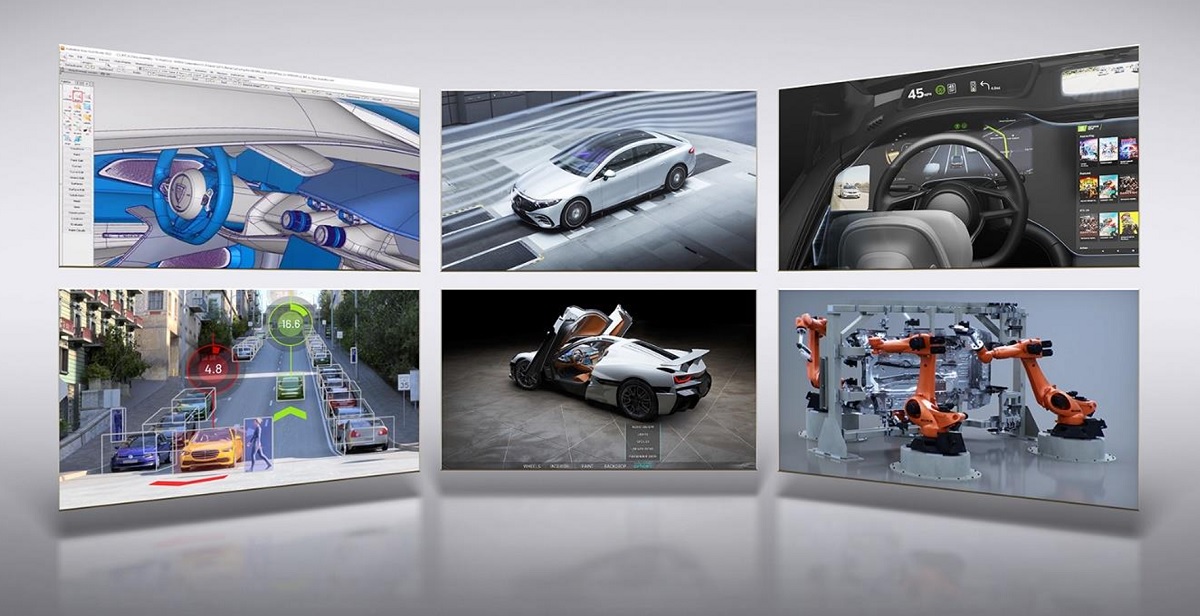|
Getting your Trinity Audio player ready...
|
Connect with top gaming leaders in Los Angeles at GamesBeat Summit 2023 this May 22-23. Register here.
Nvidia said that its Omniverse platform for virtual designs is being adopted by carmakers along with its AI platforms.
At its Nvidia GTC 2023 spring online event, Nvidia also said BYD, the world’s largest electric vehicle maker, has partnered with Nvidia for software-defined vehicles built on the Nvidia Drive platform.
The automotive industry is undergoing a digital revolution, driven by breakthroughs in accelerated computing, AI and the industrial metaverse, said Ali Kani, vice president of automotive at Nvidia, in a press briefing.
“We aim to accelerate the entire automotive workflow,” Kani said.
Event
GamesBeat Summit 2023
Join the GamesBeat community in Los Angeles this May 22-23. You’ll hear from the brightest minds within the gaming industry to share their updates on the latest developments.
Automakers are digitalizing (OK, not sure that’s a word) every phase of the product lifecycle — including concept and styling, design and engineering, software and electronics, smart factories, autonomous driving and retail — using the Nvidia Omniverse platform (a metaverse for engineers) and AI, he said.
Based on the Universal Scene Description (USD) framework, Omniverse transforms complex 3D workflows, allowing teams to connect and customize 3D pipelines and simulate large-scale, physically accurate virtual worlds. By taking the automotive product workflow into the virtual world, automakers can bypass traditional bottlenecks to save critical time and reduce cost.
By refining concepts in Omniverse, designers can visualize every facet of a car’s interior and exterior in the full context of the broader vehicle. Global teams can iterate quickly with real-time, physically based, photorealistic rendering.
For example, they can collaborate to design the cockpit’s critical components, such as digital instrument clusters and infotainment systems, which must strike a balance of communicating information while minimizing distraction.
Omniverse enables designers to flexibly lay out the cabin and cockpit onscreen user experience along with the vehicle’s physical interior to ensure a harmonious look and feel. With this next-generation design process, automakers can catch flaws early and make real-time improvements, reducing the number of physical prototypes to test and validate.
Nvidia has said it has a backlog of about $11 billion in orders through 2030 on its pipeline in the automotive sector, though the company expects to update this number.
“The scope of investment needed in automotive is just staggering,” Kani said. “They’re going through electrification now.”
As for self-driving cars, he said companies are taking their time. And he noted there is no room for error on autonomous driving.
“The value of our strategy is end to end,” Kani said.
Virtual validation
Once the design is complete, developers can use Omniverse to kick the tires on their new concepts. Perfecting the interior is necessary for customer experience as well as safety. Developers can take these in-cabin designs for a spin in the virtual world, collaborating and sharing designs for efficient refinement and validation.
Digitalization is also transforming the way automakers approach vehicle engineering. Teams can test different materials and components in a virtual environment to further reduce physical prototyping. For example, engineers can use computational fluid dynamics to refine aerodynamics and perform virtual crash simulations for safer vehicle designs.
Continuous improvement
The coming generation of vehicles are highly advanced computers on wheels, packed with complex, centralized electronic systems and software for enhanced safety, intelligence and security.
Typically, vehicle functions are controlled by dozens of electronic control units distributed throughout a vehicle. By centralizing computing into core domains, automakers can replace many components and simplify what has been an incredibly complex supply chain.
With a digital representation of this entire architecture, automakers can simulate and test the vehicle software, and then provide over-the-air updates for continuous improvement throughout the car’s lifespan — from remote diagnostics to autonomous-driving capabilities to subscriptions for entertainment and other services.
Digital-first production
Vehicle production is a colossal undertaking that requires thousands of parts and workers moving in sync. Any supply chain or production issues can lead to costly delays. With Omniverse, automakers can develop and operate complex, AI-enabled virtual environments for factory and warehouse design.
These physically based, precision-timed digital twins are the key to unlocking operational efficiencies with predictive analysis and process automation. Factory planners can access the digital twin of the factory to review and improve the plant as needed.
Every change can be quickly evaluated and validated in the virtual world, then implemented in the real world to ensure maximum efficiency and optimal ergonomics for factory workers. Additionally, automakers can synchronize plant locations anywhere in the world for scalable design and iteration.
Autonomous vehicle proving grounds
On top of enhancing traditional product development and manufacturing, Omniverse offers a complete toolchain for developing and validating automated and autonomous-driving systems.
Nvidia Drive Sim is a physically based simulation platform, built on Nvidia Omniverse, designed for fast and efficient autonomous-vehicle testing and validation at scale. It is time-accurate and supports the complete development toolchain, so developers can run simulation at the component level or for the entire system.
With DRIVE Sim, developers can repeatedly simulate routine driving scenarios, as well as rare and hazardous conditions that are too risky to test in the real world. Additionally, real-world driving recordings can be turned into reactive simulation scenarios using the platform’s Neural Reconstruction Engine.
Automakers can also fine-tune their advanced driver-assistance and autonomous-vehicle systems for New Car Assessment Program (NCAP) regulations, which evaluate the safety performance of new cars based on several crash tests and safety features.
The Drive Sim NCAP tool provides high-fidelity NCAP test protocols in simulation, so automakers can efficiently perform dedicated development and validation at scale. The ability to drive in physically based virtual environments can significantly accelerate the autonomous-vehicle development process, overcoming data collection and scenario diversity hurdles that occur in real-world testing.
Omniverse’s generative AI reconstructs previously driven routes into 3D so past experiences can be reenacted or modified.
Try before you buy
The end customer benefits from digitalization, too. Immersive technologies in Omniverse virtual reality (VR) streamed using — including 3D visualization, NVIDIA CloudXR augmented reality (AR) and — deliver consumers a more engaging experience, allowing them to explore features before making a purchase.
Prospective buyers can customize their vehicle in a car configurator materials, trim levels and more — choosing colors, interior without being limited by the physical inventory of a dealership. They can then check out the car from every angle using 3D visualization.
And with AR and VR, they can view and virtually test drive a car from anywhere. The benefits of digitalization extend beyond the automotive industry. With Omniverse, any enterprise can reimagine their workflows to increase efficiency, productivity and speed, revolutionizing the way they do business.
BYD deal
As noted above, BYD will use Nvidia’s Orin centralized compute platform in a broader range of its electric vehicles. The enhanced partnership expands BYD’s use of Drive Orin across the multiple models in its next-generation Dynasty and Ocean series of vehicles, bringing safe and intelligent vehicles to market.
Nvidia and BYD share the belief that future cars will be programmable, evolving from being based on many embedded controllers to high-performance centralized computers — with functionalities delivered and enhanced through software updates over the life of the car.
The compute horsepower from Drive Orin is critical for diverse, redundant sensor processing in real time, and provides automakers with the compute headroom to develop and support new software-driven services throughout the entire life of the vehicle.
Since entering production last year, Drive Orin — the highest-performance automotive-grade processor on the market — has become the transportation industry’s AI engine of choice for the new generation of electric vehicles, robotaxis, shuttles and trucks, Nvidia said.
The Drive Orin platform is capable of performing up to 254 trillion operations per second, enabling
VE Orin platform is capable of performing up to 254 trillion operations per second, enabling it to power AI cockpits, as well as automated driving functions — simultaneously running numerous deep neural networks to provide the ultimate safety and reliability. BYD has sold 3.7 million cars to date.
GamesBeat’s creed when covering the game industry is “where passion meets business.” What does this mean? We want to tell you how the news matters to you — not just as a decision-maker at a game studio, but also as a fan of games. Whether you read our articles, listen to our podcasts, or watch our videos, GamesBeat will help you learn about the industry and enjoy engaging with it. Discover our Briefings.


